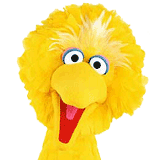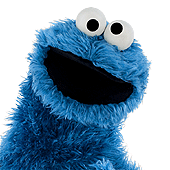Heres my two cents worth.......
As long as people take these comments the way they are meant and not personally, Katzi, I don't think you need to fear for your post being deleated. What you said is a proven fact. Back in the days when it first came out, Sesame Street used to focus not on just one, but two (sometimes more) letters and numbers in each episode. They also used to focus more on showing kids how to say and use them by showing clips and skits that were based on these things. Find an early episode and watch it and you will find it jam-packed full of educational stuff that simply couldn't be packed into a time frame of less than 60 minutes. It was a bold experiment back in 1968, that turned out to be an unbelievable success! It's goal was to get kids ready to start school by teaching them the basics of ABC's and 123's, and, in the process, encourage tollerance and discourage bigatry by showing how the different races of people in the cast were all able to live on one street and still get along in perfect harmony. Kids (like me) would sit, mezmerized, in front of the T.V. for a full hour of good, clean, educational entertainment every day. And it was a great help to school systems, as well. In fact, the things that SS taught were carried right up to the level of first grade in the education system! I remember well the hour of class time when the teacher would bring in the T.V., give us all a carton of milk to drink, and turn on Sesame Street for us to watch while he/she used the hour to correct tests and assignments and such. Today, though, I don't think teachers would be caught dead showing SS to kids at school, not just because of all the "dumbing down" the show has experienced, but also due to the extreem increase in what kids need to know before starting kindergarden. Thats why I try so hard to emphasize the fact that the way SS used to be is needed today more than ever!
The people who have now taken over SW try to rationalize and back up their actions of "dumbing down" the show by claiming that the kids watching it today are of a younger, more vulnerable age group, usually around 2-3 yrs. old, who, by "proven research", are much more suceptable to being overwhelmed by to much data being pushed on them at one sitting, and whose attention span is "proven" to last not much longer than 30 minutes, which is why "Elmo's World" was inserted. (They say it basically "fools" kids into watching the remainder of the show because they think it is a completly different show altogether, which re-charges their attention span.)The reason I have a hard time believing all that "proven research", that they now go by as if it were gosple doctrine, is the fact that I, myself, was only 3 when they aired the pilot episode, and I never had any trouble sitting through it. So unless they are claiming that an entire generation of kids today is stricken with an extreem case of A.D.D., I don't see how they could come up with such a hypothosis and call it "proven".
The way I see it, the actual reason for pushing Elmo and all of his other "younger" based character friends (i.e. - Zoe, Baby Bear, and the like) into the spotlight so much and "dumbing down" the show has a far more subtle explanation behind it, and that would be money. The real fact is this: when "Elmo" came on the show back in 85, they saw what a smash hit he was with the younger crowd. And they also saw a possible future source of income, through retail sales, when the "Tickle-me-Elmo" craze happened. By now Jim Henson was gone, along with a good chunk of the other people who had ran the show up to this point. And the people who had replaced them were eager to give the show a new make-over. When they saw all the money that "Tickle-me-Elmo" brought in, I think they knew they had struck pay dirt. Here they had finally found a way to keep their programs running without always having to rely on donations and sponsors alone for income. The only drawback was the fact that, to keep the money comming in with other types of Elmo toys, they would need to find a way to keep his popularity from dying. And in order to do so they would need to forgo concentrating so much on the concept of teaching "The Basics" and start catering to the younger kids. Making Elmo their biggest little character was how they would keep the cash flowing. Thats why Elmo is now basically the "representative" character of SS. It also gave "newbies" in the pruduction field the chance they wanted to turn over a new leaf and start producing programs and characters that they could get credit for. As a result you now have the key characters and format that SS has today.

 Welcome to the Muppet Central Forum!
Welcome to the Muppet Central Forum!.jpg) Christmas Music
Christmas Music Macy's Thanksgiving Parade
Macy's Thanksgiving Parade Sesame Street debuts on Netflix
Sesame Street debuts on Netflix Back to the Rock Season 2
Back to the Rock Season 2 Sam and Friends Book
Sam and Friends Book Jim Henson Idea Man
Jim Henson Idea Man Bear arrives on Disney+
Bear arrives on Disney+